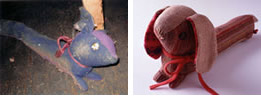 |
As I trained as knitted fabric designer, I usually start to think about textures and structures before I think about colours of the fabric. I have two knitting machines in my studio on which I constantly experiment by knitting small samples of fabric, and a lot of old knitting pattern books (my favourites are from the 1930s and 1960s). I also have a big collection of books on traditional folk costumes, which give me inspiration and remind me of the timeless beauty of knitting. |
 |
95% of my materials come from Scotland and Italy, where you find the finest spinners in the world. |
 |
I constantly look at how people wear and coordinate accessories. Then I think about the colour, pattern, size and weight of my products. I am also fortunate in that I am constantly surrounded by young and fashion-conscious people, and the combination of their enthusiasm for what is new with my knowledge of traditional craft patterns and techniques informs my design process. |
 |
 |
| left) |
tweed dog for my collection 2004-05 autumn/winter |
| right) |
doggy cushion on the floor at manufactory |
|
I work with several U.K manufacturers and knitters to produce my work, and I love visiting them and looking at their knitting and weaving machinery. Occasionally, I find some scraps of fabric on the floors of their workshops which serves as inspiration for a future collection. |
 |
I show my collection at fashion trade shows in London (London Designers Exhibition) and Paris (Showroom Hortensia De Hutten) twice a year and find that these shows provide the best opportunity to meet fashion buyers from all over the world. |
|
|